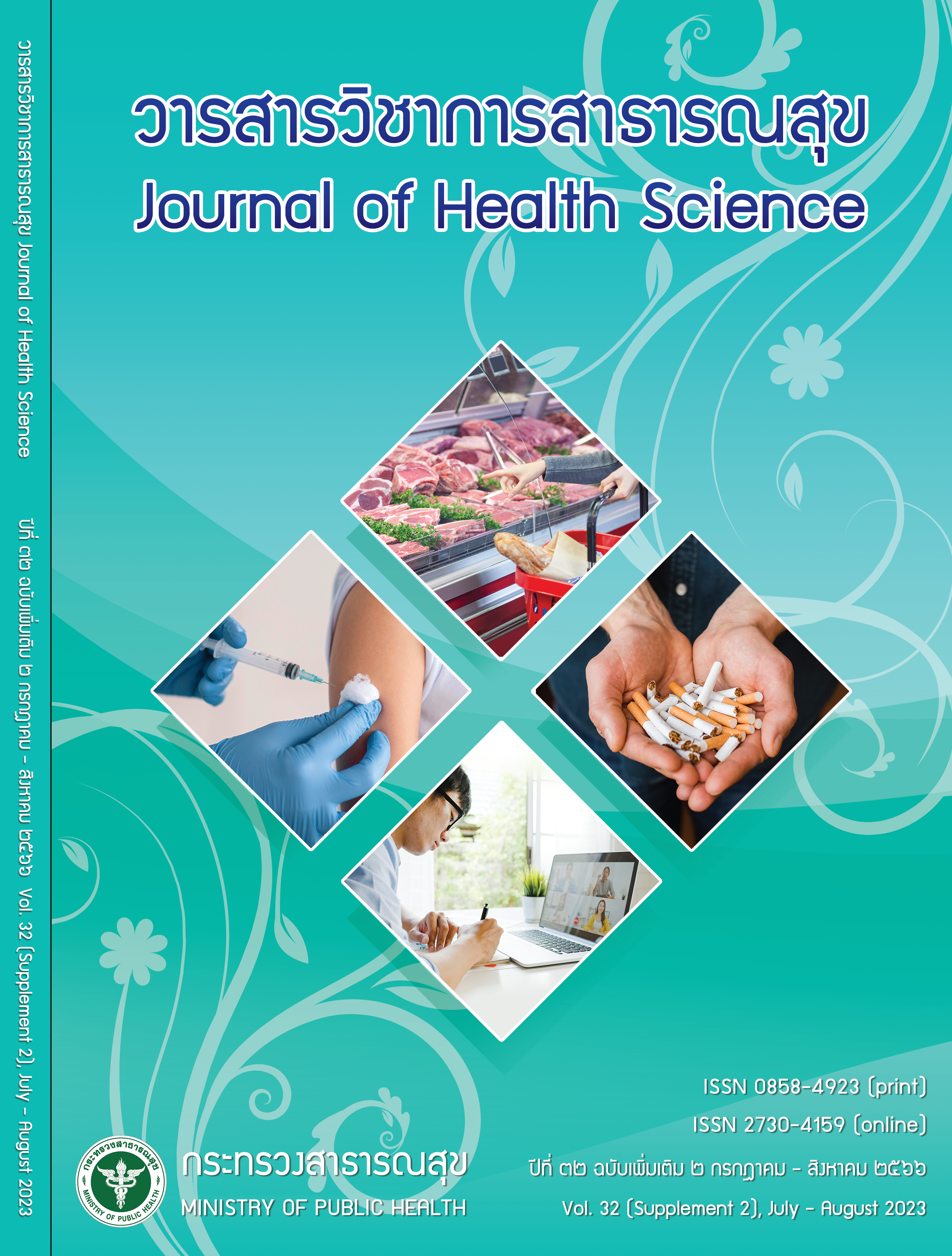Effectiveness of the 21st Century Play Model on Emotional and Social Skills in Thai Early Childhood
Keywords:
play, early childhood, emotional and social skills, effectivenessAbstract
The recent Thai early childhood’s situation showed that emotional and social development was ranked as 2nd least developmental domain along early childhood development standards. Moreover, only a small proportion of children and caregivers played together. The Department of Health, therefore, developed a play model to promote Thai children’s development and skills in 21st century. This study aimed to assess effectiveness of the play model in the contexts of home and early childhood development center on the emotional and social skills in early childhood. It took samples of 415 children aged 3-6 years old in 5 provinces, namely Chiangmai, Ratchaburi, Nonthaburi, Khon Kaen and Nakhon Si Thammarat. The samples were devided into 2 age groups: 399 children aged 3-5 years old using the Thai Emotional Quotient (EQ) Questionnaire for children aged 3-5 years old (brief version) and 263 children aged 4-6 years old using the Strengths and Difficulties Questionnaire (SDQ) to assess the children’s emotional and social skills along their age. In addition, average scores before (pre-scores) and after (post-scores) using the play model in each group were analyzed by Wilcoxon’s test. Also, KruskalWallis test was applied to analyze the pre-scores, post-scores and the difference of pre-scores and post-scores (diff-scores). It was found that, for the children aged 3-5 years old, the post-scores of the Thai EQ Questionnaire significantly increased in control group, home group and early childhood development center group (p<0.05). In the case of the 4-6 year-old children, the post-scores of behavioral problems from the SDQ significantly decreased in control group and home group (p<0.05). In addition, there were significant differences among the 4 groups (the control, the home group, the early childhood development center group, and the mixed home and childhood development center group) (p<0.05). Consequently, the Department of Health should emphasize the widespread use of this play model in order to prepare and promote emotional and social skills in Thai early childhood for 21st century
Downloads
References
สำนักอนามัยการเจริญพันธุ์ กรมอนามัย กระทรวงสาธารณสุข. แผนปฏิบัติการภายใต้นโยบายและยุทธศาสตร์ การพัฒนาอนามัยการเจริญพันธุ์แห่งชาติ ฉบับที่ 2 (พ.ศ. 2560-2569) ว่าด้วยการส่งเสริมการเกิดและการเจริญ เติบโตอย่างมีคุณภาพ พ.ศ. 2560-2562. นนทบุรี: ชุมนุมสหกรณ์การเกษตรแห่งประเทศไทย จำกัด; 2560.
คณะกรรมการพัฒนาอนามัยการเจริญพันธุ์แห่งชาติ. นโยบายและยุทธศาสตร์ การพัฒนาอนามัยการเจริญพันธุ์ แห่งชาติ ฉบับที่ 2 (พ.ศ.2560-2569) ว่าด้วยการส่งเสริม การเกิดและการเจริญเติบโตอย่างมีคุณภาพ [อินเทอร์เน็ต]. [สืบค้นเมื่อ 31 พ.ค. 2564]. แหล่งข้อมูล: http://202. 29.80.118/datas/document/PolicyandStrategy/strategic/strategic-reproductive-59.pdf
ไทยพีบีเอส. สธ. เปิดสถิติเด็กไทยเกิดต่ำกว่า 600,000 คน ครั้งแรกในรอบ 3 ปี [อินเทอร์เน็ต]. [สืบค้น 31 พ.ค. 2564]. แหล่งข้อมูล: https://news.thaipbs.or.th/content/301313
กรมอนามัย. ร้อยละของเด็ก อายุ 0-5 ปี ทั้งหมดตาม ช่วงอายุที่กำหนดมีพัฒนาการสมวัย (สมวัยครั้งทีสอง) ระดับ ่ เขตสุขภาพ [อินเทอร์เน็ต]. [สืบค้นเมื่อ 1 มิ.ย. 2564]. แหล่ง ข้อมูล: https://dashboard.anamai.moph.go.th/dashboard/ dspm?year=2021
สำนักงานสถิติแห่งชาติ. รายงานผลฉบับสมบูรณ์ การสำรวจ สถานการณ์เด็กและสตรีในประเทศไทย พ.ศ. 2562. กรุงเทพมหานคร: สำนักงานสถิติแห่งชาติ; 2563.
วรรณจรี มณีแสง. ปัญหาพฤติกรรมของนักเรียนอนุบาลและ ระดับประถมศึกษาในโรงเรียนเขตชุมชนมหาวิทยาลัยเวสเทิร์น วิทยาเขตวัชรพล [อินเทอร์เน็ต]. [สืบค้นเมื่อ 7 มิ.ย. 2564]. แหล่งข้อมูล: https://oldweb.western.ac.th/ media/attachments/2017/09/13/kinderkarten.pdf
ชาตรี วิฑูรชาติ. เลี้ยงลูกอย่างไรให้มี EQ ดี [อินเทอร์เน็ต]. [สืบค้นเมื่อ 16 มิ.ย. 2564]. แหล่งข้อมูล: https://www. si.mahidol.ac.th/sidoctor/e-pl/articledetail.asp?id=684
สำนักส่งเสริมและพัฒนาสุขภาพจิต กรมสุขภาพจิต. คู่มือ การจัดกิจกรรมเสริมสร้างอีคิวเด็กปฐมวัย สำหรับครูใน ศูนย์พัฒนาเด็กเล็ก. พิมพ์ครั้งที่ 5. กรุงเทพมหานคร: พรอสเพอรัสพลัส; 2561.
ปิยนันท์ พูลโสภา. การพัฒนาการเล่น เพื่อการเรียนรู้ของ เด็กปฐมวัยในศตวรรษที่ 21. วารสารศึกษาศาสตร์ปริทัศน์ 2560;32(1):20-7.
American Academy of Pediatrics. The power of play: a pediatric role in enhancing development in young children. Pediatrics 2018;142(3):1-16.
กลุ่มสนับสนุนวิชาการและการวิจัย สำนักส่งเสริมสุขภาพ กรมอนามัย. รายงานการศึกษาปัจจัยที่มีผลต่อพัฒนาการ เด็กปฐมวัยไทยครั้งที่ 6 พ.ศ. 2560 [อินเทอร์เน็ต]. [สืบค้น เมื่อ 1 ก.ค. 2564]. แหล่งข้อมูล: https://hp.anamai.moph. go.th/download/article/article_20190225123524.pdf
Burdette HL, Whitaker RC. Resurrecting free play in young children. Arch Pediatr Adolesc Med 2005;159(1): 46-50.
American Academy of Pediatrics. The importance of play in promoting healthy child development and maintaining strong parent-child bonds. Pediatrics 2007;119(1):182- 91.
Mainella FP, Agate JR, Clark BS. Outdoor-based play and reconnection to nature: A neglected pathway to positive youth development. New Dir Youth Dev 2011; 2011(130);89-104.
อดิศร์สุดา เฟื่องฟู. ของเล่นและการเล่นเพื่อส่งเสริม พัฒนาการตามวัย. ใน: ทิพวรรณ หรรษคุณาชัย, รวิวรรณ รุ่งไพรวัลย์, สุรีย์ลักษณ์ สุจริตพงศ์, วีระศักดิ์ ชลไชยะ, บรรณาธิการ. ตำราพัฒนาการและพฤติกรรมเด็ก เล่ม 3 การ ดูแลเด็กสุขภาพดี. กรุงเทพมหานคร: บียอนด์ เอ็นเทอร์ไพรซ์; 2556. หน้า 335-48.
กองแผนงาน กรมอนามัย. แผนยุทธศาสตร์การพัฒนาระบบ ส่งเสริมสุขภาพและอนามัยสิ่งแวดล้อมตามแผนพัฒนาสุขภาพแห่งชาติ ในช่วงแผนพัฒนาเศรษฐกิจและสังคมแห่งชาติ ฉบับที่ 12 (พ.ศ.2563-2565) ฉบับปรับปรุง. กรุงเทพมหานคร: อักษรกราฟฟิคแอนด์ดีไซน์; 2563.
อดุลย์ วังศรีคูณ. การศึกษาไทยในศตวรรษที่ 21: ผลผลิต และแนวทางการพัฒนา. วารสารมนุษยศาสตร์และสังคมศาสตร์ บัณฑิตวิทยาลัย มหาวิทยาลัยราชภัฏพิบูลสงคราม 2557;8(1):1-17.
Partnership for 21st Century Learning. 21st Century learning for early childhood framework [Internet]. 2019 [cited 2021 Jun 29]. Available from: http://static.battelleforkids.org/documents/p21/P21EarlyChildhoodFramework.pdf
Partnership for 21st Century Learning. 21st Century learning for early childhood guide [Internet]. 2019 [cited 2021 Jun 29]. Available from: http://static.battelleforkids.org/documents/p21/P21EarlyChildhoodGuide. pdf
ปิยลัมพร หะวานนท์, วสันต์ ปัญญาแสง. การพิจารณาขนาด ตัวอย่าง. ใน: พิเชฐ สัมปทานุกุล, บรรณาธิการ. หลักการ ทำวิจัยสู่ความสำเร็จในการปฏิบัติ. กรุงเทพมหานคร: โฟคัลอิมเมจพริ้นติ้งกรุป; 2554. หน้า 255-71.
จรณิต แก้งกังวาล, ประตาป สิงหศิวานนท์. ขนาดกลุ่ม ตัวอย่างในการวิจัยทางคลินิก [อินเทอร์เน็ต]. [สืบค้นเมื่อ 1 ก.ค. 2564]. แหล่งข้อมูล: https://rdo.psu.ac.th/ResearchStandards/animal/assets/document/SampleSizes. pdf
กระทรวงสาธารณสุข. คู่มือเฝ้ าระวังและส่งเสริมพัฒนาการ เด็กปฐมวัย developmental surveillance and promotion manual (DSPM). กรุงเทพมหานคร: องค์การสงเคราะห์- ทหารผ่านศึก; 2564.
คลังความรู้สุขภาพจิต กรมสุขภาพจิต. แบบประเมินความ ฉลาดทางอารมณ์ เด็กอายุ 3-5 ปี (ฉบับย่อ) สำหรับครู/ ผู้ดูแล [อินเทอร์เน็ต]. [สืบค้นเมื่อ 9 ก.พ. 2564]. แหล่งข้อมูล: https://dmh-elibrary.org/items/show/306.
คลังความรู้สุขภาพจิต กรมสุขภาพจิต. แบบประเมินความ ฉลาดทางอารมณ์ เด็กอายุ 3-5 ปี (ฉบับย่อ) สำหรับพ่อแม่ ผู้ปกครอง [อินเทอร์เน็ต]. [สืบค้นเมื่อ 9 ก.พ. 2564]. แหล่ง ข้อมูล: https://dmh-elibrary.org/items/show/305
กาญจนา วณิชรมณีย์, เยาวนาฏ ผลิตนนท์เกียรติ, อมรากุล อินโอชานนท์, เสาวลักษณ์ สุวรรณไมตรี, อรวรรณ ดวงจันทร์. การพัฒนาแบบประเมินความฉลาดทางอารมณ์เด็ก อายุ 3-5 ปี และ 6-11 ปี (ฉบับย่อ). วารสารราชานุกูล 2558;30(1):1-7.
Goodman R. The strengths and difficulties questionnaires: questionnaires etc. View and download [Internet]. 2020 [cited 2021 Jun 29]. Available from: https://www. sdqinfo.org/py/sdqinfo/b3.py?language=Thai
ยงยุทธ วงศ์ภิรมย์ศานติ์ , พรรณพิมล วิปุลากร, สุภาวดี นวลมณี, โวฟกัง เวิร์นเนอร์, อภิชัย มงคล. แบบประเมิน จุดแข็งและจุดอ่อน (SDQ: ฉบับภาษาไทย): การเปลี่ยนแปลง และแนวทางการใช้. วารสารสุขภาพจิตแห่งประเทศไทย 2554;19(2):128-34.
ทวีศักดิ์ สิริรัตน์เรขา. การคัดกรองสุขภาพจิตเด็กวัยเรียน. กรุงเทพมหานคร: บียอนด์พับลิสชิ่ง; 2560.
จรณิต แก้งกังวาล, ประตาป สิงหศิวานนท์. พื้นฐานสถิติที่ ใช้ในการวิจัยทางคลินิก [อินเทอร์เน็ต]. [สืบค้นเมื่อ 1 ก.ค. 2564]. แหล่งข้อมูล:https://rdo.psu.ac.th/ResearchStandards/animal/assets/document/SampleSizes.pdf
Howard J, McInnes K. The impact of children’s perception of an activity as play rather than not play on emotional well-being. Child Care Health Dev 2013;39(5): 737-42.
Richard S, Baud-Bovy G, Clerc-Georgy A, Gentaz E. The effects of a ‘pretend play-based training’ designed to promote the development of emotion comprehension, emotion regulation, and prosocial behaviour in 5- to 6-year-old Swiss children. Br J Psychol 2021;112(3): 690-719.
Sezgin E, Demiriz S. Effect of play-based educational programme on behavioral self-regulation skills of 48-60 month-old children. Early Child Dev Care 2019; 189(7):1110-13.
Petersen H, Holodynski M. Bewitched to be happy? The impact of pretend play on emotion regulation of expression in 3- to 6-year-olds. J Genet Psychol 2020;181(2- 3):111-26.
Downloads
Published
How to Cite
Issue
Section
License

This work is licensed under a Creative Commons Attribution-NonCommercial-NoDerivatives 4.0 International License.



